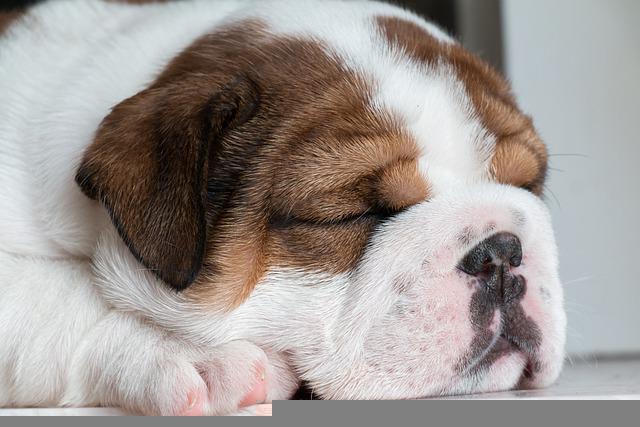10 Ways on How to Calm a Dog Down in a Car? By Experts
Taking your dog with you for long drives is a dream for any canine lover but it can be pretty hard to achieve if your dog cowers at the sight of the car or starts shaking or throwing up once inside the car. There are several reasons a dog may be scared or wary of traveling in the car, such as past trauma like a car accident, motion sickness, general anxiety about traveling in a closed vehicle, or something as simple as having only traveled to a vet when in a car. Therefore, they start to associate car trips with unpleasant events.
- 1-Eliminate Your Dog’s Fear of Cars
- 2-Get Your Dog to Look Forward to Car Rides
- 3-How to Deal with Dog’s Motion Sickness?
- 4- Get Some Company for Your Dog
- 5- Music Helps!
- 6- So Do Essential Oils!
- 7- Comfortable Environment is Also Important!
- 8- Exhaust Your Dog Before Going for A Ride
- 9- Don’t Forget the Safety Harness!
- 10- Prepare for the journey
It’s not something to be upset about if your dog displays anxiety while traveling in a vehicle or hates car trips. With the right approach and training, these issues can be overcome. In this article, we will discuss some of the core issues responsible for the problem and 10 proven ways that will help your dog to calm down and be a model passenger. Because a fretful dog not only makes even small trips difficult but can be dangerous as his pacing might distract the driver.
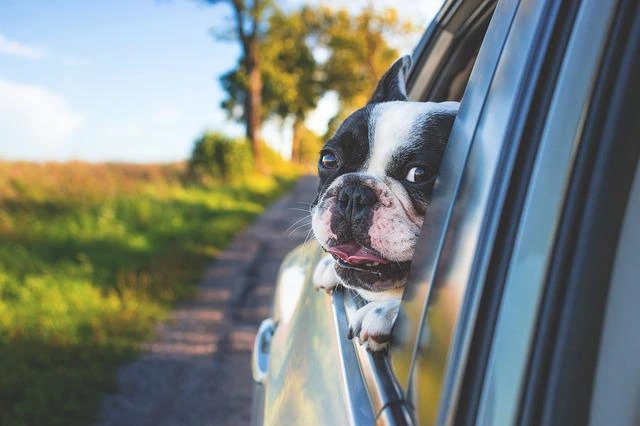
1-Eliminate Your Dog’s Fear of Cars
The first step towards a peaceful ride with your dog is to get him in the car without being scared or stressed. As simple as it may sound, it is difficult to tempt puppies into entering closed vehicles, while the previously traumatized adult dogs have their reasons for not approaching the car. To handle this issue; there are two ways:
I. Desensitizing
Desensitizing is slowly introducing a puppy to the car and getting him to think of it as a safe area. If you plan on going on road trips with your dog, start the desensitizing process when your dog is young, so he never learns to associate car rides with anxiety or fear. In the beginning, leave the doors of your car open, put your pup’s favorite treat inside the car and let him approach the car at his own pace. He might not enter the car at all in the first few tries, be patient and keep trying till your puppy is comfortable jumping in and out of the car. Once your puppy can enter the car without any fear, join him and sit beside him, give him treats, or do things he likes, such as scratching his ears, giving him a massage, or rubbing his belly.
When your puppy starts thinking of the car as his territory, gradually move to the driver’s seat with your puppy in the back seat, praise your puppy and give him occasional treats. The next step is to turn on the engine for a few minutes before turning it off. Keep repeating the steps until your puppy is relaxed in his back seat while the engine remains running.
II. Counter Conditioning
Counter conditioning is the process through which dogs that have previously been traumatized by cars are taught to love car rides again. Your dog may dislike car rides because of some minor or major event that occurred in the car that frightened him; therefore, he does not want to set a paw in the vehicle again. If your dog belongs to this category, start the counter-conditioning process with the aim that you are going to make your dog believe that good things happen inside the car. Begin with shifting the playtime with your dog outside where your car is parked.
When starting, do not get so close to the car that your dog starts displaying signs of fear. Initially, maintain a distance from the car so that your dog is comfortable and relaxed, and then move closer by gradually enticing your dog with treats and making him associate being near the car with his beloved playtime. As your dog gets comfortable being around the car, move him closer still by playing games like fetch and throwing the ball close to the vehicle. If he gets the ball, reward him with treats and praises for choosing to approach the car on his own. Over time, this will help eliminate his fear of the vehicle itself, and then you can start working on getting him to relax inside the car by following the desensitizing steps mentioned above.
When counter-conditioning, patience is the key. It is not a sprint and small steps are more likely to succeed. Your dog’s negative associations with the car are being changed to positive ones by making all of his favorite things happen there.
2-Get Your Dog to Look Forward to Car Rides
The second step to an enjoyable ride with your dog is to get him to anticipate his destination and be excited to go for car rides instead of suffering through them. You can achieve this by avoiding a common mistake that dog owners make, which is the classic conditioning of the dog into thinking that car rides only lead to bad places. The reason for dogs forming such associations is because their owners only take them to the groomer and vet. It can also be due to the absence of counter-conditioning the poor dog after any traumatizing event involving the car in the past.
Start with taking the car out of the driveway or taking short trips around the block. Make the trips enjoyable by giving treats to your pup and praising him. Frequently visit parks and other places where you can play with your pup and give him treats. In this way, your dog will start looking forward to riding in the car because he knows that car rides will lead to fun, food, and playing with his hooman. Over time, the dog will not need the additional treats and praises to enjoy riding in the car. For the occasional visits to the vet or groomer, you can sweeten the ride by giving your pooch his favorite toy or snack.
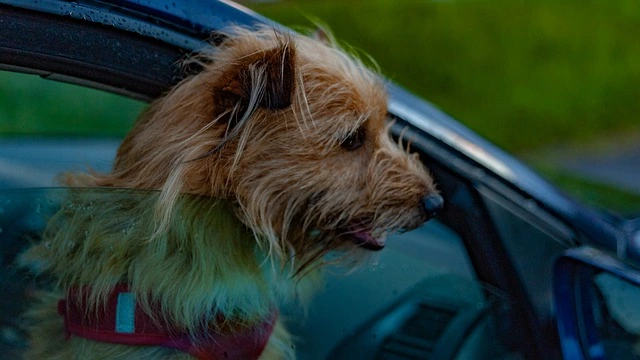
3-How to Deal with Dog’s Motion Sickness?
For some dogs, it’s not the general anxiety of traveling in the car but motion sickness that makes car rides unbearable. Especially for puppies, motion sickness is more common. Although, often at a year’s mark, motion sickness generally subsides. Dogs experiencing motion sicknesses may display signs such as heavy drooling, pacing, whimpering, howling, nausea, and vomiting.
Dogs that experience motion sickness will need medications to deal with it. Motion sickness medicines for dogs are easily available at pet stores but consult your vet before trying any medicine to deal with your pup’s problem. Never use human car sickness meds for your dog without your vet’s advice, as they may cause severe reactions Over time, your dog can start tolerating short rides without nausea and vomiting but will probably still need meds for longer rides.
Some other ways to deal with motion sickness are:
1- Sitting the dog in such a manner that he can look out the window. You can get dog car seats or simply elevate the dog by putting folded blankets under him.
2- If possible, keep the windows open as the fresh air helps with nausea. Remember to not let your dog put his face out of the window, as that can result in an injury.
3- If it is hot outside, consider turning on the car AC to keep the car cool.
4- Avoid large meals for two hours before car rides.
While training a dog who gets nauseous during car rides, remember to be patient and gentle. Do not shout at the dog, if he ends up vomiting in the backseat, chances are he is already more distraught than you are. Your chastising will only make the condition worse and may even end up traumatizing the dog. The better option is to get puppy pads in the backseat on which you can sit your dog and keep cleaning supplies in the car for accidents.
4- Get Some Company for Your Dog
If your dog is extremely agitated during car rides, barking, howling, or pacing around in the back seat without calming down, it can be stressful for you but more importantly, it can distract you which is something that should be avoided at all costs while driving. Therefore, if possible, ask for a friend to ride in the back with your dog. Not only will the companionship calm down your dog, as your friend can pat the dog, cuddle, and talk to him but having a person keeping an eye on the dog will also help in alerting you if the dog seems to be feeling queasy or needs to relieve himself and thus you can make a stop in time to avoid having a mess to clean up in your backseat.
You can gradually start training the dog to go without an extra passenger by talking to him in a soothing voice, tossing treats in the back, and taking shorter trips before going for a long ride. Remember to remain calm, even if the dog does something you do not like, and keep talking in a soft voice to the dog. Do not forget to make multiple stops so that your dog can relieve himself.
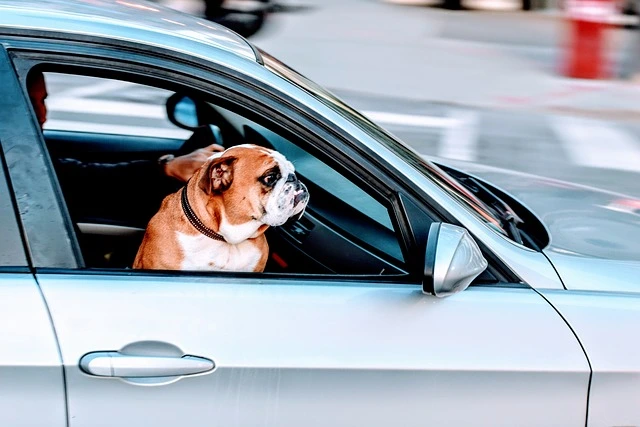
5- Music Helps!
As strange as it may sound, the power of music in calming down is not only limited to humans. Music can also calm down pets, such as cats and dogs. Granted, you are not blasting bass in the speakers and scaring the poor animal more than it already is. Soft classical music has been proven to help relax dogs; thus, it is an easy solution you can use in calming your over-excited dog in the back seat. Just play some music and let it do its magic.
You can also take this a step farther by putting a specific song on repeat when you play with your pup or while giving him food, and then play the same song when you go for a car trip. Since the dog has come to associate that music with good memories, it will help relax him a bit and will hopefully calm him down during the ride. If you are confused about the song choice, consider choosing solo piano music with simple arrangements and a slow tempo of sound, soft rock, or a piece of reggae music, as this type of music has been most successful in reducing anxiety among dogs, according to the various studies conducted on the impact of music on dogs.
6- So Do Essential Oils!
An organic approach to the car problem is using essential oils for calming dogs in the car. Several options of essential oils are available, including chamomile, hemp seed oil, lavender, ginger, or frankincense. These oils have varying purposes, such as relaxing nerves, soothing the dog’s stomach, decreasing stress, reducing nausea, and calming the dog. The best way is to get essential oils made specifically for dogs, but if you are unable to acquire those, you can take the general essential oil and dilute it for your pup in the ratio of 10 drops per 60 ml of water.
Before using essential oils, consult your vet because not all oils are good for dogs, some may be toxic for them. You can spray the oil in the dog’s bedding in the back seat or the general area but avoid spraying directly on the dog as it may irritate the dog’s skin. Essential oils are also available as chewable tablets for dogs. Cannabidiol, commonly known as CBD oil, has also helped quite a few dog owners in easing the anxiety and upset stomachs of their dogs. Although, no study has been conducted to prove its effectiveness, yet.
7- Comfortable Environment is Also Important!
A comfortable environment can go a long way in calming your dog. Make the back seat of your car as homey and comfortable as possible for your dog by putting fluffy blankets, your dog’s favorite toys, or a traveling canine bed in the back seat of your car. So, your car appeals to the dog, and he enjoys spending time in his sanctuary while gazing out the window or taking naps. Another key way of relaxing dogs is by spraying calming pheromones in the car. Pheromones are certain chemical signals which animals use to communicate with each other.
In this case, the pheromone you are looking for is Adaptil, a pheromone released by the nursing mama dog, for a few days after giving birth to a litter. This pheromone, which has been artificially replicated, helps the pups in relaxing and calming during their early days. Similarly, spraying Adaptil in the car or having an Adaptil pheromone collar around your pup’s neck while riding the car will help your dog relax and enjoy the ride instead of growling or cowering his way through it. Adaptil is available as Comfort Zone commercially, in the form of spray bottles which you can use to spritz the back seat or even in the form of dog collars.
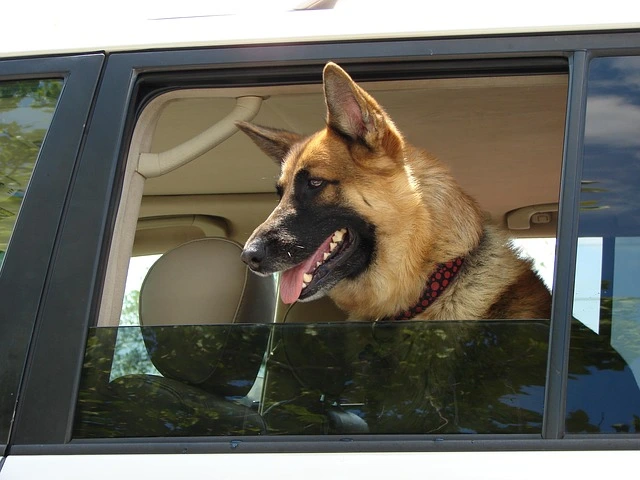
8- Exhaust Your Dog Before Going for A Ride
Your dog is more likely to be active and on edge, if he has a lot of energy to burn during the trip. Before going for a ride with your pup, take him for a walk, let him play with other dogs or let the dog play with children. The more energy he expends, the easier it will be to ride peacefully. Maintain your pup’s heart rate a bit higher than normal for up to 30 minutes before he gets in the car for the trip, or simply play with him for the length of time you normally do to exhaust his frantic appetite for playing. Doing this will ensure that your dog is not restless and agitated in the car purely because of pent-up energy, as this issue can be dealt with easily and without the hassle of calming an over-excited dog in the car.
9- Don’t Forget the Safety Harness!
Securing your dog during the car ride is equally as important as wearing seat belts is for humans. Though you can’t use the seat belts on dogs, there are other safer options, including travel pods and carriers for puppies or small dogs, harnesses for medium-sized dogs, or a crate for large dogs. The harness for your pup depends on his size, comfort level, and the type of car you drive. Investing in a dog-specific car safety device will help you in several ways, such as preventing the dog from pacing in the backseat or jumping through the gap into the front seat which is highly likely to distract you and in the worst-case scenario can cause an unfortunate accident.
Safety harnesses are also extremely beneficial in calming down the dogs in the car, as some dogs like the feeling of being physically secure in the moving vehicle. If your dog refuses to get in the harness, you can try dog-specific jackets meant to reduce anxiety in dogs, they help calm down the dogs while on their first few rides. Although, you can continue to use them if your dog likes them.
10- Prepare for the journey
The best way for enjoying a peaceful ride with your dog is to prepare beforehand for the ride. You should know which things to take with you, and what steps to follow, to make the ride easier for your pup and subsequently for you, too. Before going for a ride, do not feed your pup a large meal for about two hours but don’t starve your poor pup for hours either, as that causes nausea. When initially taking your dog out for rides, make multiple stops for the dog to stretch his legs outside and relieve himself. With time, you can decrease the number of stops when your dog becomes car trained.
Moving forward to what you need to pack for long car rides, you should include basic stuff like food and cold water with their respective bowls, treats and a few of his favorite toys for occasions when you need to tempt your pup into obedience, a strong leash for taking your dog out to relieve himself, and most importantly cleaning supplies, such as poop bags, spray cleaner and car air freshener. At the beginning of the training, accidents are bound to occur and it’s always much better to be already prepared for such a mess than to be stuck in a stinking car.


